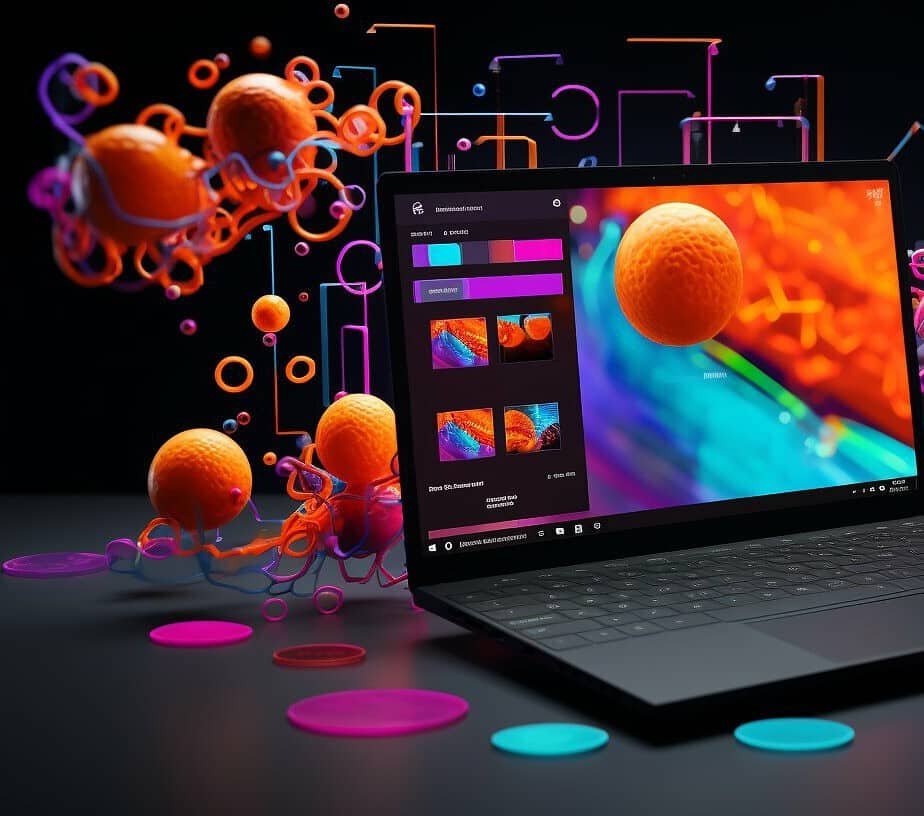Are you tired of struggling with complex interfaces while trying to create your vision? Designing and creating can be a challenging process, but with the right tools, it doesn’t have to be. Enter: Drag and Drop Interface. This user-friendly and easy-to-use feature makes the design process effortless and enjoyable. With a simple drag and drop, you can create stunning designs that match your vision in no time.
In this article, we’ll explore the importance of a drag and drop interface while designing, how it works, its advantages, and drawbacks. You’ll also learn about designing with a drag and drop interface, how to choose the right one, and how other companies have used it to improve their user experience. So, let’s dive in and discover how you can create your vision effortlessly with a drag and drop interface.
Understanding Drag and Drop Interface
Drag and drop interface refers to the intuitive design in which users can move items around the screen by “dragging” them and “dropping” them into place. This interactive user interface is an essential component of modern design tools, allowing designers to create beautiful and complex designs with ease.
The efficiency of the drag and drop system is a big advantage, reducing the time and effort required to create something from scratch. It simplifies the design process, making it easier for users to apply their ideas and visions with precision.
With a drag and drop interface, users can easily pick elements and move them around, reducing the risk of errors and enabling quick changes. The system offers a user-friendly interface that streamlines the design process, ultimately improving the product’s overall quality and functionality.
Benefits of Drag and Drop Interface
A drag and drop interface comes with several benefits for designers and creators. Here are some of the advantages of using a drag and drop feature:
- Saves Time: With drag and drop functionality, designers can easily move elements around the canvas without redrawing them. This saves a lot of time and effort as compared to traditional design methods.
- Efficient: The seamless drag and drop feature ensures that anything on the canvas can be moved around and placed with ease. This makes the design process more efficient, and designers can focus on creating the perfect layout.
- User-Friendly: Drag and drop interface is incredibly user-friendly, making it easy for both professionals and amateurs to create stunning designs. The easy-to-use interface ensures that anyone can use it without prior design knowledge.
- Stunning Designs: With drag and drop interface, designers can create stunning designs quickly and easily. The seamless functionality enables the creation of interactive user interfaces that attract more users.
- Drag and Drop Website Builder: Drag and drop website builders like Wix and Squarespace make it easy for anyone to create a website without any coding knowledge. These builders come with pre-designed templates and layouts that are easy to customize with drag and drop functionality.
Overall, a drag and drop interface is an efficient way to create stunning designs and layouts with ease. It saves time, is user-friendly, and creates stunning designs that attract more users.
How to Implement Drag and Drop Interface
Implementing drag and drop functionality in the design process requires careful consideration of several factors, including a user-friendly interface and intuitive design. Here are the steps to implement a seamless drag and drop interface:
- Choose a drag and drop website builder with an easy-to-use interface. Ensure that the website builder offers the features needed to create your desired design.
- Identify the components that need to be included in your design. Ensure that the drag and drop feature is enabled for each component.
- Place the components on the design interface by dragging and dropping them into the desired location. Adjust the size and position of the components as needed.
- Review the design to ensure it meets your requirements. Test the design on different devices and browsers to ensure compatibility.
- Make any necessary changes or adjustments, and repeat the testing process until you are satisfied with the design.
Remember, a good drag and drop interface should allow you to create your vision quickly and easily. A user-friendly interface ensures that the design process is intuitive, and therefore, less time-consuming. With a clear vision and precise execution, you can create an effective design that will enhance the user experience.
Examples of Drag and Drop Interface in Action
Here are some examples of popular websites and applications that use a drag and drop interface for designing:
| Website/Application Name | Description |
|---|---|
| Weebly | Weebly is a drag and drop website builder that allows users to create websites quickly and easily. Its intuitive interface and drag and drop functionality make it very user-friendly. |
| Canva | Canva is a graphic design platform that features a drag and drop interface for designing social media graphics, presentations, posters, and more. Its easy-to-use interface and pre-designed templates make it very popular among non-designers. |
| Trello | Trello is a project management tool that uses a drag and drop interface to help users organize and prioritize tasks. Its interactive user interface allows for seamless collaboration among team members. |
These examples demonstrate how using a drag and drop interface can lead to an interactive user experience and an easy-to-use interface, which can attract more users to a product.
The Drawbacks of Drag and Drop Interface
While drag and drop interfaces are known for their ease-of-use and efficiency, they do have their limitations.
One major drawback is the limited scope of design. Since drag and drop features are designed to be seamless and straightforward, users may not have the flexibility to create complex designs or customize them extensively. This can be frustrating for users who want to create a unique design that stands out from the competition.
Another disadvantage is the potential for limited functionality. While many drag and drop website builders offer a wide range of features and tools, some may not provide full customization options. This can be a hindrance for designers who need more advanced functionality in their work.
Despite these drawbacks, drag and drop interfaces are still an excellent tool for designers looking to create simple, user-friendly designs quickly and efficiently.
Designing with Drag and Drop Interface
Designing with a drag and drop interface is an intuitive and user-friendly process that allows designers to bring their vision to life. To get started with designing using the drag and drop interface, follow these simple steps:
- Choose a drag and drop website builder or design software that fits your needs and budget. Check if the interface allows customized designs or offers pre-made templates.
- Plan out your website’s design, keeping in mind the user’s perspective. Identify the elements you want to include on each page, such as text, images, videos, or animations. Create a rough sketch of the layout and the placement of these elements.
- Log in to the website builder or design software and start a new project. Select a template or a blank canvas.
- Drag and drop the elements from the toolbar in the desired location on the canvas or template. Resize, rotate, or delete the elements as necessary.
- Add text by simply clicking on the text box and entering the content. You can customize the font, size, color, and alignment of the text.
- Include images by dragging them from the library or your desktop onto the canvas. You can crop, resize, or adjust the orientation of the images.
- Preview your design and make changes as necessary, keeping in mind the user’s perspective and ease of use.
- Publish your design and make it live on the internet. Test the design’s functionality, speed, and compatibility with different devices and operating systems.
Designing with drag and drop interface requires a clear vision, precise execution, and a user-friendly interface. By following these simple steps, you can create an effective and visually appealing design that attracts more users and improves the user experience.
Factors to Consider While Choosing Drag and Drop Interface
Choosing the right drag and drop interface can be challenging, especially with so many products available in the market. Here are a few factors to consider:
| Factor | Description |
|---|---|
| Complexity of design | The interface should have the necessary tools to handle the complexity of the design. If you’re planning to create complex designs, opt for an interface that offers advanced features. |
| Scalability | Ensure the interface has the scalability to handle your future design needs. It should be able to adapt to changing design requirements without any major changes. |
| Customization options | Choose an interface that has flexible customization options. Avoid interfaces that limit your creativity and restrict design possibilities. |
In addition to the above factors, consider the efficiency of the drag and drop system. The interface should have a smooth and easy-to-use system that ensures a seamless process. Also, if you’re looking for a quick design option, consider a drag and drop website builder.
Conclusion:
With these factors in mind, you can now choose the right drag and drop interface that fits your design requirements. Remember, a user-friendly interface with efficient drag and drop functionality can save you time, effort and resources, so choose wisely.
Case studies on how Drag and Drop Interface improved UX
Several companies have adopted a drag and drop interface to create an excellent user experience. Here are some case studies that showcase the effectiveness of a drag and drop interface in improving UX:
1. Wix
Wix is a website builder platform that offers a drag and drop interface. With this interface, users can easily customize and create stunning websites. The platform has an intuitive and user-friendly design, making it easy for even beginners to create professional-looking sites. The drag and drop interface provided by Wix allows users to choose from a vast library of pre-designed templates, which can then be easily customized using the drag and drop functionality. This feature has made it one of the most popular website builder platforms, with over 160 million users worldwide.
2. Canva
Canva is a graphic design platform that offers a drag and drop interface to create social media graphics, posters, flyers, and much more. The platform’s drag and drop interface allows users to add and customize different design elements quickly. Canva has a vast library of templates, images, and graphics, which can be easily edited using the drag and drop functionality. The platform has a user-friendly interface that makes it easy for beginners to create professional designs. With over 20 million active users, Canva has become one of the most popular graphic design platforms worldwide.
3. Mailchimp
Mailchimp is an email marketing platform that offers a drag and drop interface to create email campaigns. The platform’s drag and drop interface allows users to add and customize different design elements, such as text, images, and buttons, quickly. The platform has an intuitive and user-friendly design that makes it easy for beginners to create professional-looking email campaigns. This feature has made Mailchimp one of the most popular email marketing platforms, with over 7 million users worldwide.
These case studies show that a drag and drop interface can significantly improve the user experience. The seamless and straightforward functionality of a drag and drop interface allows users to create stunning designs quickly. An intuitive and user-friendly interface increases the accessibility and usability of the platform, attracting more users and improving UX.
Can the Drag and Drop Interface be Used to Create an App Like WhatsApp?
Yes, the drag and drop interface can be used for making an app like whatsapp. This user-friendly method allows developers to easily move and arrange elements on the screen without any coding knowledge. With drag and drop functionality, designers can create intuitive layouts, interactive buttons, and seamless user experiences, just like WhatsApp.
FAQ’s about Drag and Drop Interface
If you’re new to using drag and drop interface, you may have some questions about how it works and how to make the most of its features. Here are some frequently asked questions:
How do I troubleshoot issues while using drag and drop interface?
If you’re experiencing issues with the drag and drop functionality, try clearing your cache and cookies, or restarting your device. If the issue persists, contact the support team of the website or application you’re using. They should be able to provide you with assistance to resolve the issue.
How can I create a user-friendly interface with drag and drop interface?
To create a user-friendly interface, focus on keeping the design simple and intuitive. Use clear labels and instructions, and minimize clutter on the interface. Allow users to easily navigate through the interface by using clear icons, buttons, and menus.
How can I enhance drag and drop functionality?
To enhance drag and drop functionality, ensure that the system is responsive and has a swift drag and drop system. Consider providing keyboard shortcuts, allowing users to manipulate the design from a keyboard, making the whole process much more efficient. Remember to keep the drag and drop interface easily accessible and intuitive for the best user experience.
With these tips in mind and a user-friendly drag and drop interface, you can create stunning designs quickly and efficiently, and greatly improve the overall user experience.




0 Comments